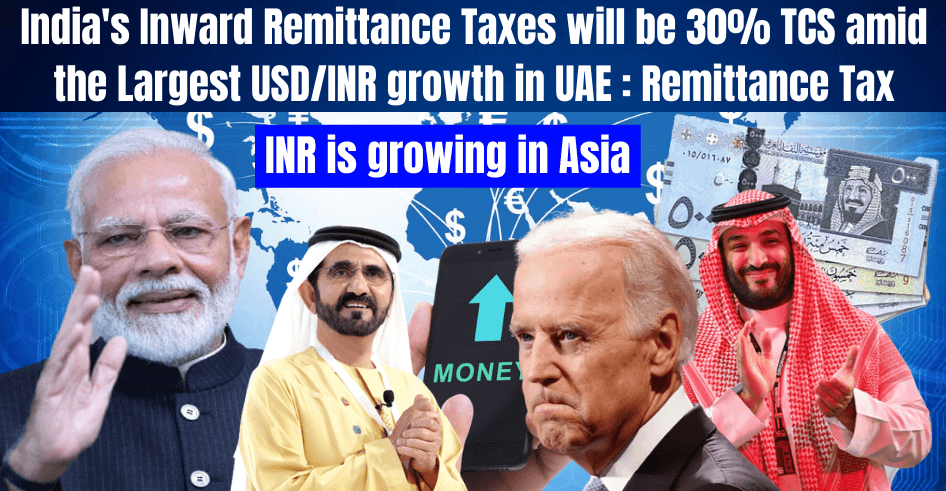427 Views
India’s Inward Remittance Taxes will be 30% TCS amid the Largest USD/INR growth in UAE : Remittance Tax
Indian Rupees becoming most powerful currency in 2025, Investing in USD/INR forex, Why Indian Government impose a 30% TCS tax or Inward or Outward Remittance to the US, UK, and Singapore?.

Due to the recent increase in inward remittances from the US, Saudi Arabia, UAE, Malaysia, Singapore, and the United Kingdom within India, the Indian government can now plan to increase taxes and fees on international transactions. Currently, India’s other remittances are being received the most in the world due to which to further strengthen the Government’s Indian Rupees or Banking-finance services, now the 20% TCS applicable on regular remittances can be increased to 30%. Now trade has been started for Indian currency outside UAE, in which trade between UAE and Indian banks can also be done in other local currencies which can be done through top remittance receivers of UAE through international business, foreign money transfers, or international payment solutions. Therefore, INR/AED can be used instead of USD in outward or inward remittances.
Why Indian Government impose a 30% TCS tax or Inward or Outward Remittance to the US, UK, and Singapore?
After the US, United Kingdom, Singapore, and Saudi Arabia, the UAE can also use Indian Currency for International Business due to which UAE can get a lot of achievement in taxes or payment solutions on USD because AED/INR pairs are now global. So now India’s foreign remittances can be increased a bit which will strengthen the Indian currency and Indian Rupees will be the world’s largest international currency after the Asian yuan in place of USD. Recently, there has been an inward inflow remittance of about $130 billion USD in India, which has made India the top remittance or International Payments solution country in the world. And in everyone’s accounts, the Indian Government will see the Indian Rupee strengthening against the USD in the next few years and top investors also want to have a stake in the Indian economy.

Japan and South Korea to jointly fight Chinese, IRGC and North Korean soldiers in Ukraine

US Venture Capital Firms reduce investment in Israel during Lebanon war, Israel Bankrupt

US firms may invest $100B in the US Defense ETF, A begins Taiwan and Korean war

IRGC has its own ‘Laser-guided’ and hydrogen secret bombs that are superior to Nuclear weapons

Italy and France could Possibly join BRICS in 2025, Italy Suspend aid to Ukraine and Israel

Israel to ban TikTok and Chinese Apps amid war against Hezbollah and Iran

Russian commando Forces retake Kursk region from NATO-Ukraine Occupy

Belarus allow North Korean Troops to fight against NATO and Western Ukraine

US demands Israel to Strike the Iranian Oil Refinery and US fears an Attack on Nuclear Sites of Iran

Turkey could send military aid or troops to Lebanon against Israel

US Venture Capital Firms reduce investment in Israel during Lebanon war, Israel Bankrupt

US firms may invest $100B in the US Defense ETF, A begins Taiwan and Korean war

China Stop aiding Pakistan, IMF affects Belt and Road Project of China

Macroeconomics improves BRICS to reduce Debt, Inflation, and Interest Rates : BRICS Vs G20

Gary Gensler fears Resignation and fires from SEC after Elon Musk Twitter Testimony

iPhone XS max eligible for iOS 18 update, AI Features, iphone 16 review, iPhone Camera

Apple Stock Highest price is expected to be $300 by 2025, Mass buy of $AAPL Stock in 2025

Nurse Salary in Luxembourg may reach $10000 per month in 2025 : Nurse Salary jobs

Saudi Investing in Badminton Sports, What is Badminton and Badminton Revenue reach $10B by 2025.

Shah Rukh Khan Pays the Highest Taxes in World by Surpassing Tom Cruise In year 2024

UAE spends $100M on Tech, Finance, and Educational Blogger in 2024 : blogging future

Starlink could offer free web hosting for business, government and private sectors in 2025

Cheap and Best Cloud VPS Hosting for Blogging and Digital marketing in 2025

Elon Musk will reinstate Bassem Youssef, X may lose millions of Creators and stakeholders

Google Sending Organic Traffic to OpenAi, New websites Traffic down : Website Traffic

Earn $1000 Per Month using Facebook bonus program or Upload your photos : Facebook Monetization

Earn $100 per day on X, Write Articles, Increase Posts Impression, Bitcoin News: Twitter Monetization

Alex Fasulo may earn $100M by 2025 at home by Freelancing and Blogging : Blogging 2025

Earn 10X revenues on Ezoic & Ad Manager than AdSense, Media.net and Taboola in 2025


